

Compact Muon Solenoid
LHC, CERN
| CMS-PAS-TOP-23-008 | ||
| Measurement of inclusive and differential cross sections for single top quark production in association with a W boson in proton-proton collisions at $ \sqrt{s}= $ 13.6 TeV | ||
| CMS Collaboration | ||
| 27 March 2024 | ||
| Abstract: The first measurement of the inclusive and normalised differential cross sections for the production of single top quarks in association with a W boson in proton-proton collisions at a centre-of-mass energy of 13.6 TeV are presented. The data used were recorded with the CMS detector at the LHC during 2022, and correspond to an integrated luminosity of 34.7 fb$^{-1}$. The analyzed events contain one muon and one electron in the final state. For the inclusive measurement, multivariate discriminants are used exploiting the kinematic properties of the events to separate the signal from the dominant top quark antiquark production background. A cross section of 84.1 $ \pm $ 2.1 (stat) $^{+9.8}_{-10.2}$ (syst) $\pm$ 3.3 (lumi) pb is obtained, consistent with the predictions of the standard model. A fiducial region is defined according to the detector acceptance for performing the differential measurements. The resulting differential distributions are unfolded to particle level and show good agreement with the predictions at next-to-leading order in perturbative quantum chromodynamics. | ||
| Links: CDS record (PDF) ; Physics Briefing ; CADI line (restricted) ; | ||
| Figures | |

png pdf |
Figure 1:
Leading-order Feynman diagrams for single top quark production in the $ \mathrm{t}\mathrm{W} $ mode. The charge-conjugate modes are implicitly included. |

png pdf |
Figure 1-a:
Leading-order Feynman diagrams for single top quark production in the $ \mathrm{t}\mathrm{W} $ mode. The charge-conjugate modes are implicitly included. |

png pdf |
Figure 1-b:
Leading-order Feynman diagrams for single top quark production in the $ \mathrm{t}\mathrm{W} $ mode. The charge-conjugate modes are implicitly included. |

png pdf |
Figure 2:
Feynman diagrams for $ \mathrm{t}\mathrm{W} $ single top quark production at NLO that are removed from the signal definition in the DR scheme. The charge-conjugate modes are implicitly included. |

png pdf |
Figure 2-a:
Feynman diagrams for $ \mathrm{t}\mathrm{W} $ single top quark production at NLO that are removed from the signal definition in the DR scheme. The charge-conjugate modes are implicitly included. |

png pdf |
Figure 2-b:
Feynman diagrams for $ \mathrm{t}\mathrm{W} $ single top quark production at NLO that are removed from the signal definition in the DR scheme. The charge-conjugate modes are implicitly included. |

png pdf |
Figure 2-c:
Feynman diagrams for $ \mathrm{t}\mathrm{W} $ single top quark production at NLO that are removed from the signal definition in the DR scheme. The charge-conjugate modes are implicitly included. |
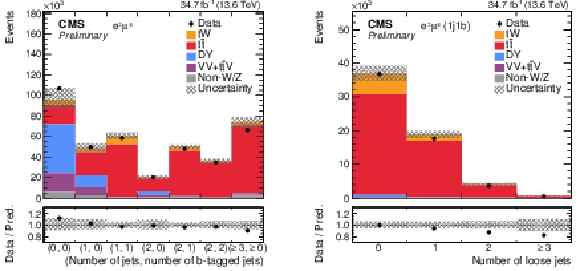
png pdf |
Figure 3:
Left: the number of events observed in data (points) and predicted from simulation (filled histograms) in the $ \mathrm{e}^\pm\mu^\mp $ sample as a function of the number of jets and b-tagged jets before the maximum likelihood fit. Right: the number of loose jets per event in the $ \mathrm{e}^\pm\mu^\mp $ sample from the 1j1b region before the maximum likelihood fit. The vertical bars on the points show the statistical uncertainties in the data. The hatched band represents the sum of the statistical and systematic uncertainties in the MC predictions. The lower panels show the ratio of data to the sum of the expected yields. |

png pdf |
Figure 3-a:
Left: the number of events observed in data (points) and predicted from simulation (filled histograms) in the $ \mathrm{e}^\pm\mu^\mp $ sample as a function of the number of jets and b-tagged jets before the maximum likelihood fit. Right: the number of loose jets per event in the $ \mathrm{e}^\pm\mu^\mp $ sample from the 1j1b region before the maximum likelihood fit. The vertical bars on the points show the statistical uncertainties in the data. The hatched band represents the sum of the statistical and systematic uncertainties in the MC predictions. The lower panels show the ratio of data to the sum of the expected yields. |

png pdf |
Figure 3-b:
Left: the number of events observed in data (points) and predicted from simulation (filled histograms) in the $ \mathrm{e}^\pm\mu^\mp $ sample as a function of the number of jets and b-tagged jets before the maximum likelihood fit. Right: the number of loose jets per event in the $ \mathrm{e}^\pm\mu^\mp $ sample from the 1j1b region before the maximum likelihood fit. The vertical bars on the points show the statistical uncertainties in the data. The hatched band represents the sum of the statistical and systematic uncertainties in the MC predictions. The lower panels show the ratio of data to the sum of the expected yields. |

png pdf |
Figure 4:
Distributions from data (points) and MC simulations (filled histograms) before the maximum likelihood fit of the four most discriminating variables used for the RF training of the 1j1b region: (upper left) the $ p_{\mathrm{T}} $ of the leading loose jet; (upper right) the $ p_{\mathrm{T}} $ of the leading lepton; (lower left) the magnitude of the transverse momentum of the dilepton + jet system; and (lower right) the invariant mass of the dilepton system. The last bin of each distribution includes the overflow events, except for the leading loose jet $ p_{\mathrm{T}} $ distribution, which is only defined up to 30 GeV. The first bin in the upper left plot contains events with 0 loose jets. The vertical bars on the points give the statistical uncertainty in the data, and the hatched band represents the sum of the statistical and systematic uncertainties in the MC predictions. The lower panels show the ratio of the data to the sum of the MC predictions. |

png pdf |
Figure 4-a:
Distributions from data (points) and MC simulations (filled histograms) before the maximum likelihood fit of the four most discriminating variables used for the RF training of the 1j1b region: (upper left) the $ p_{\mathrm{T}} $ of the leading loose jet; (upper right) the $ p_{\mathrm{T}} $ of the leading lepton; (lower left) the magnitude of the transverse momentum of the dilepton + jet system; and (lower right) the invariant mass of the dilepton system. The last bin of each distribution includes the overflow events, except for the leading loose jet $ p_{\mathrm{T}} $ distribution, which is only defined up to 30 GeV. The first bin in the upper left plot contains events with 0 loose jets. The vertical bars on the points give the statistical uncertainty in the data, and the hatched band represents the sum of the statistical and systematic uncertainties in the MC predictions. The lower panels show the ratio of the data to the sum of the MC predictions. |

png pdf |
Figure 4-b:
Distributions from data (points) and MC simulations (filled histograms) before the maximum likelihood fit of the four most discriminating variables used for the RF training of the 1j1b region: (upper left) the $ p_{\mathrm{T}} $ of the leading loose jet; (upper right) the $ p_{\mathrm{T}} $ of the leading lepton; (lower left) the magnitude of the transverse momentum of the dilepton + jet system; and (lower right) the invariant mass of the dilepton system. The last bin of each distribution includes the overflow events, except for the leading loose jet $ p_{\mathrm{T}} $ distribution, which is only defined up to 30 GeV. The first bin in the upper left plot contains events with 0 loose jets. The vertical bars on the points give the statistical uncertainty in the data, and the hatched band represents the sum of the statistical and systematic uncertainties in the MC predictions. The lower panels show the ratio of the data to the sum of the MC predictions. |

png pdf |
Figure 4-c:
Distributions from data (points) and MC simulations (filled histograms) before the maximum likelihood fit of the four most discriminating variables used for the RF training of the 1j1b region: (upper left) the $ p_{\mathrm{T}} $ of the leading loose jet; (upper right) the $ p_{\mathrm{T}} $ of the leading lepton; (lower left) the magnitude of the transverse momentum of the dilepton + jet system; and (lower right) the invariant mass of the dilepton system. The last bin of each distribution includes the overflow events, except for the leading loose jet $ p_{\mathrm{T}} $ distribution, which is only defined up to 30 GeV. The first bin in the upper left plot contains events with 0 loose jets. The vertical bars on the points give the statistical uncertainty in the data, and the hatched band represents the sum of the statistical and systematic uncertainties in the MC predictions. The lower panels show the ratio of the data to the sum of the MC predictions. |
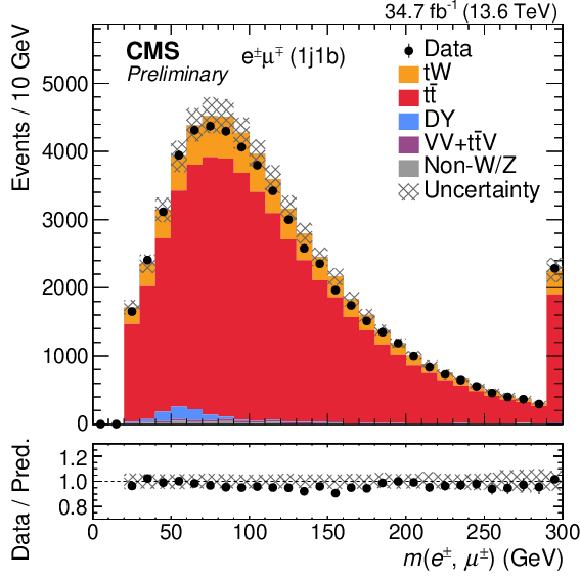
png pdf |
Figure 4-d:
Distributions from data (points) and MC simulations (filled histograms) before the maximum likelihood fit of the four most discriminating variables used for the RF training of the 1j1b region: (upper left) the $ p_{\mathrm{T}} $ of the leading loose jet; (upper right) the $ p_{\mathrm{T}} $ of the leading lepton; (lower left) the magnitude of the transverse momentum of the dilepton + jet system; and (lower right) the invariant mass of the dilepton system. The last bin of each distribution includes the overflow events, except for the leading loose jet $ p_{\mathrm{T}} $ distribution, which is only defined up to 30 GeV. The first bin in the upper left plot contains events with 0 loose jets. The vertical bars on the points give the statistical uncertainty in the data, and the hatched band represents the sum of the statistical and systematic uncertainties in the MC predictions. The lower panels show the ratio of the data to the sum of the MC predictions. |

png pdf |
Figure 5:
The measured distributions from data (points) and MC simulations (filled histograms) before the maximum likelihood fit of the six observables used to measure the $ \mathrm{t}\mathrm{W} $ differential cross sections. Signal events in the 1j1b region with 0 loose jets (0 $ \mathrm{j}_{\text{l}} $) are selected. The last bin of each distribution contains the overflow events. The vertical bars on the data show the statistical uncertainty. The hatched band displays the sum of the statistical and systematic uncertainties in the MC predictions. The lower panels show the ratio of the data to the sum of the MC expectations. |
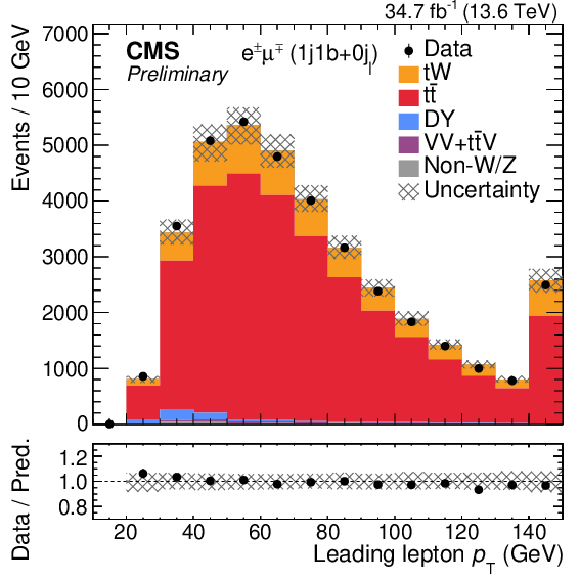
png pdf |
Figure 5-a:
The measured distributions from data (points) and MC simulations (filled histograms) before the maximum likelihood fit of the six observables used to measure the $ \mathrm{t}\mathrm{W} $ differential cross sections. Signal events in the 1j1b region with 0 loose jets (0 $ \mathrm{j}_{\text{l}} $) are selected. The last bin of each distribution contains the overflow events. The vertical bars on the data show the statistical uncertainty. The hatched band displays the sum of the statistical and systematic uncertainties in the MC predictions. The lower panels show the ratio of the data to the sum of the MC expectations. |

png pdf |
Figure 5-b:
The measured distributions from data (points) and MC simulations (filled histograms) before the maximum likelihood fit of the six observables used to measure the $ \mathrm{t}\mathrm{W} $ differential cross sections. Signal events in the 1j1b region with 0 loose jets (0 $ \mathrm{j}_{\text{l}} $) are selected. The last bin of each distribution contains the overflow events. The vertical bars on the data show the statistical uncertainty. The hatched band displays the sum of the statistical and systematic uncertainties in the MC predictions. The lower panels show the ratio of the data to the sum of the MC expectations. |

png pdf |
Figure 5-c:
The measured distributions from data (points) and MC simulations (filled histograms) before the maximum likelihood fit of the six observables used to measure the $ \mathrm{t}\mathrm{W} $ differential cross sections. Signal events in the 1j1b region with 0 loose jets (0 $ \mathrm{j}_{\text{l}} $) are selected. The last bin of each distribution contains the overflow events. The vertical bars on the data show the statistical uncertainty. The hatched band displays the sum of the statistical and systematic uncertainties in the MC predictions. The lower panels show the ratio of the data to the sum of the MC expectations. |

png pdf |
Figure 5-d:
The measured distributions from data (points) and MC simulations (filled histograms) before the maximum likelihood fit of the six observables used to measure the $ \mathrm{t}\mathrm{W} $ differential cross sections. Signal events in the 1j1b region with 0 loose jets (0 $ \mathrm{j}_{\text{l}} $) are selected. The last bin of each distribution contains the overflow events. The vertical bars on the data show the statistical uncertainty. The hatched band displays the sum of the statistical and systematic uncertainties in the MC predictions. The lower panels show the ratio of the data to the sum of the MC expectations. |

png pdf |
Figure 5-e:
The measured distributions from data (points) and MC simulations (filled histograms) before the maximum likelihood fit of the six observables used to measure the $ \mathrm{t}\mathrm{W} $ differential cross sections. Signal events in the 1j1b region with 0 loose jets (0 $ \mathrm{j}_{\text{l}} $) are selected. The last bin of each distribution contains the overflow events. The vertical bars on the data show the statistical uncertainty. The hatched band displays the sum of the statistical and systematic uncertainties in the MC predictions. The lower panels show the ratio of the data to the sum of the MC expectations. |

png pdf |
Figure 5-f:
The measured distributions from data (points) and MC simulations (filled histograms) before the maximum likelihood fit of the six observables used to measure the $ \mathrm{t}\mathrm{W} $ differential cross sections. Signal events in the 1j1b region with 0 loose jets (0 $ \mathrm{j}_{\text{l}} $) are selected. The last bin of each distribution contains the overflow events. The vertical bars on the data show the statistical uncertainty. The hatched band displays the sum of the statistical and systematic uncertainties in the MC predictions. The lower panels show the ratio of the data to the sum of the MC expectations. |
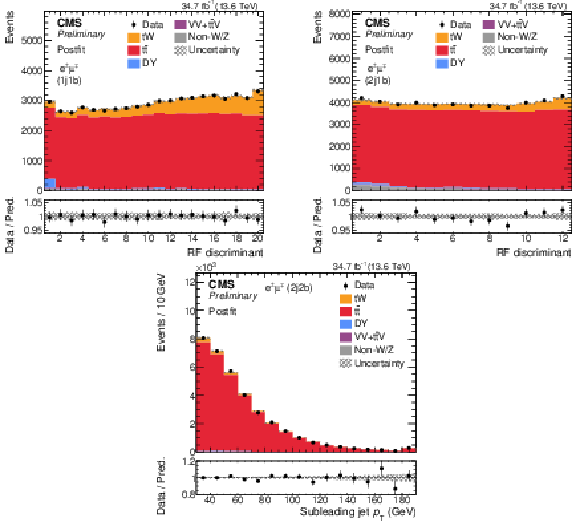
png pdf |
Figure 6:
The distributions of the RF outputs for events in the 1j1b (upper left) and 2j1b (upper right) regions, and the subleading jet $ p_{\mathrm{T}} $ for the 2j2b region (lower). The data (points) and the MC predictions (filled histograms) after the maximum likelihood fit are shown. The vertical bars on the points represent the statistical uncertainty in the data, and the hatched band the total uncertainty in the MC prediction. The lower panels display the ratio of the data to the sum of the MC (points) predictions after the fit, with the bands giving the corresponding uncertainties. |

png pdf |
Figure 6-a:
The distributions of the RF outputs for events in the 1j1b (upper left) and 2j1b (upper right) regions, and the subleading jet $ p_{\mathrm{T}} $ for the 2j2b region (lower). The data (points) and the MC predictions (filled histograms) after the maximum likelihood fit are shown. The vertical bars on the points represent the statistical uncertainty in the data, and the hatched band the total uncertainty in the MC prediction. The lower panels display the ratio of the data to the sum of the MC (points) predictions after the fit, with the bands giving the corresponding uncertainties. |

png pdf |
Figure 6-b:
The distributions of the RF outputs for events in the 1j1b (upper left) and 2j1b (upper right) regions, and the subleading jet $ p_{\mathrm{T}} $ for the 2j2b region (lower). The data (points) and the MC predictions (filled histograms) after the maximum likelihood fit are shown. The vertical bars on the points represent the statistical uncertainty in the data, and the hatched band the total uncertainty in the MC prediction. The lower panels display the ratio of the data to the sum of the MC (points) predictions after the fit, with the bands giving the corresponding uncertainties. |

png pdf |
Figure 6-c:
The distributions of the RF outputs for events in the 1j1b (upper left) and 2j1b (upper right) regions, and the subleading jet $ p_{\mathrm{T}} $ for the 2j2b region (lower). The data (points) and the MC predictions (filled histograms) after the maximum likelihood fit are shown. The vertical bars on the points represent the statistical uncertainty in the data, and the hatched band the total uncertainty in the MC prediction. The lower panels display the ratio of the data to the sum of the MC (points) predictions after the fit, with the bands giving the corresponding uncertainties. |

png pdf |
Figure 7:
The $ \mathrm{t}\mathrm{W} $ cross section as a function of $ \sqrt{s} $, as obtained in this analysis (red filled circle) and in previous measurements by the CMS experiment [22,4,28,29 ] (black markers), with vertical bars on the markers indicating the total uncertainty in the measurements. Points corresponding to measurements at the same $ \sqrt{s} $ are horizontally shifted for better visibility. The SM prediction [15,16,17] is shown with a black line and blue uncertainty bands. |

png pdf |
Figure 8:
The twenty largest impacts $ \Delta\hat{\mu} $ (right column) and fit constraints $ (\hat{\theta}-\theta_0)/\Delta\theta $ (middle column) of the nuisance parameters listed in the left column from the ML fit used to determine the inclusive $ \mathrm{t}\mathrm{W} $ cross section. The horizontal bars on the fit constraints show the ratio of the uncertainties of the fit result to the previous ones, effectively giving the constraint on the nuisance parameter. If the period is specified alongside the uncertainty name, it indicates that this is the component of the uncertainty uncorrelated by periods. There are two possible periods, before (2022PreEE) and after (2022PostEE) ECAL water leak. The JES uncertainties are divided into several sources, where ``JES - absolute'' groups contributions from scale corrections in the barrel, pileup corrections, and initial- and final-state radiation corrections; ``JES - relative sample'' encodes the uncertainty in the $ \eta $-dependent calibration of the jets; ``JES - BBEC1'' refers to pileup removal in the barrel (BB) and the first part of the endcaps (1.3 $ < |\eta| < $ 2.5; EC1) and also a contribution from scale corrections in the barrel; and ``JES - flavour QCD'' comes from the corrections applied to correct the different detector response to gluon and quark jets. This last uncertainty is split by jet flavour in three components. These components are: light for the gluon and up, down and strange quark jets, charm for the c jets and bottom for the b jets. |

png pdf |
Figure 9:
Normalised fiducial differential $ \mathrm{t}\mathrm{W} $ production cross section as functions of the $ p_{\mathrm{T}} $ of the leading lepton (upper left), $ p_\mathrm{z}(\mathrm{e}^\pm, \mu^\mp, j) $ (upper right), $ p_{\mathrm{T}} $ of the jet (middle left), $ m(\mathrm{e}^\pm, \mu^\mp, j) $ (middle right), $ \Delta\varphi(\mathrm{e}^\pm, \mu^\mp) $ (lower left), and $ m_{\mathrm{T}}(\mathrm{e}^\pm, \mu^\mp, j, {\vec p}_{\mathrm{T}}^{\kern1pt\text{miss}}) $ (lower right). The vertical bars on the points give the statistical uncertainty in the data, the horizontal bars show the bin width. Predictions from POWHEG (PH) + PYTHIA8 (P8) DR and DS, POWHEG + HERWIG 7 (H7) DR, MadGraph-5_aMC@NLO (aMC) + PYTHIA8 DR, DR2, DS, and DS with a dynamic factor are also shown. The grey band represents the statistical uncertainty and the orange band the total uncertainty. In the lower panels, the ratio of the predictions to the data is shown. |
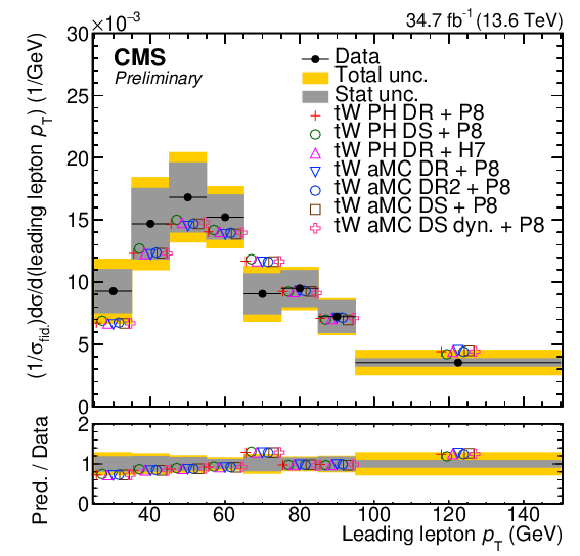
png pdf |
Figure 9-a:
Normalised fiducial differential $ \mathrm{t}\mathrm{W} $ production cross section as functions of the $ p_{\mathrm{T}} $ of the leading lepton (upper left), $ p_\mathrm{z}(\mathrm{e}^\pm, \mu^\mp, j) $ (upper right), $ p_{\mathrm{T}} $ of the jet (middle left), $ m(\mathrm{e}^\pm, \mu^\mp, j) $ (middle right), $ \Delta\varphi(\mathrm{e}^\pm, \mu^\mp) $ (lower left), and $ m_{\mathrm{T}}(\mathrm{e}^\pm, \mu^\mp, j, {\vec p}_{\mathrm{T}}^{\kern1pt\text{miss}}) $ (lower right). The vertical bars on the points give the statistical uncertainty in the data, the horizontal bars show the bin width. Predictions from POWHEG (PH) + PYTHIA8 (P8) DR and DS, POWHEG + HERWIG 7 (H7) DR, MadGraph-5_aMC@NLO (aMC) + PYTHIA8 DR, DR2, DS, and DS with a dynamic factor are also shown. The grey band represents the statistical uncertainty and the orange band the total uncertainty. In the lower panels, the ratio of the predictions to the data is shown. |

png pdf |
Figure 9-b:
Normalised fiducial differential $ \mathrm{t}\mathrm{W} $ production cross section as functions of the $ p_{\mathrm{T}} $ of the leading lepton (upper left), $ p_\mathrm{z}(\mathrm{e}^\pm, \mu^\mp, j) $ (upper right), $ p_{\mathrm{T}} $ of the jet (middle left), $ m(\mathrm{e}^\pm, \mu^\mp, j) $ (middle right), $ \Delta\varphi(\mathrm{e}^\pm, \mu^\mp) $ (lower left), and $ m_{\mathrm{T}}(\mathrm{e}^\pm, \mu^\mp, j, {\vec p}_{\mathrm{T}}^{\kern1pt\text{miss}}) $ (lower right). The vertical bars on the points give the statistical uncertainty in the data, the horizontal bars show the bin width. Predictions from POWHEG (PH) + PYTHIA8 (P8) DR and DS, POWHEG + HERWIG 7 (H7) DR, MadGraph-5_aMC@NLO (aMC) + PYTHIA8 DR, DR2, DS, and DS with a dynamic factor are also shown. The grey band represents the statistical uncertainty and the orange band the total uncertainty. In the lower panels, the ratio of the predictions to the data is shown. |

png pdf |
Figure 9-c:
Normalised fiducial differential $ \mathrm{t}\mathrm{W} $ production cross section as functions of the $ p_{\mathrm{T}} $ of the leading lepton (upper left), $ p_\mathrm{z}(\mathrm{e}^\pm, \mu^\mp, j) $ (upper right), $ p_{\mathrm{T}} $ of the jet (middle left), $ m(\mathrm{e}^\pm, \mu^\mp, j) $ (middle right), $ \Delta\varphi(\mathrm{e}^\pm, \mu^\mp) $ (lower left), and $ m_{\mathrm{T}}(\mathrm{e}^\pm, \mu^\mp, j, {\vec p}_{\mathrm{T}}^{\kern1pt\text{miss}}) $ (lower right). The vertical bars on the points give the statistical uncertainty in the data, the horizontal bars show the bin width. Predictions from POWHEG (PH) + PYTHIA8 (P8) DR and DS, POWHEG + HERWIG 7 (H7) DR, MadGraph-5_aMC@NLO (aMC) + PYTHIA8 DR, DR2, DS, and DS with a dynamic factor are also shown. The grey band represents the statistical uncertainty and the orange band the total uncertainty. In the lower panels, the ratio of the predictions to the data is shown. |

png pdf |
Figure 9-d:
Normalised fiducial differential $ \mathrm{t}\mathrm{W} $ production cross section as functions of the $ p_{\mathrm{T}} $ of the leading lepton (upper left), $ p_\mathrm{z}(\mathrm{e}^\pm, \mu^\mp, j) $ (upper right), $ p_{\mathrm{T}} $ of the jet (middle left), $ m(\mathrm{e}^\pm, \mu^\mp, j) $ (middle right), $ \Delta\varphi(\mathrm{e}^\pm, \mu^\mp) $ (lower left), and $ m_{\mathrm{T}}(\mathrm{e}^\pm, \mu^\mp, j, {\vec p}_{\mathrm{T}}^{\kern1pt\text{miss}}) $ (lower right). The vertical bars on the points give the statistical uncertainty in the data, the horizontal bars show the bin width. Predictions from POWHEG (PH) + PYTHIA8 (P8) DR and DS, POWHEG + HERWIG 7 (H7) DR, MadGraph-5_aMC@NLO (aMC) + PYTHIA8 DR, DR2, DS, and DS with a dynamic factor are also shown. The grey band represents the statistical uncertainty and the orange band the total uncertainty. In the lower panels, the ratio of the predictions to the data is shown. |
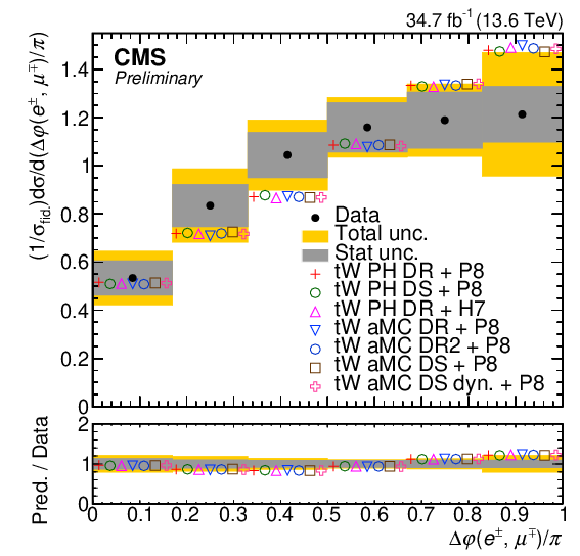
png pdf |
Figure 9-e:
Normalised fiducial differential $ \mathrm{t}\mathrm{W} $ production cross section as functions of the $ p_{\mathrm{T}} $ of the leading lepton (upper left), $ p_\mathrm{z}(\mathrm{e}^\pm, \mu^\mp, j) $ (upper right), $ p_{\mathrm{T}} $ of the jet (middle left), $ m(\mathrm{e}^\pm, \mu^\mp, j) $ (middle right), $ \Delta\varphi(\mathrm{e}^\pm, \mu^\mp) $ (lower left), and $ m_{\mathrm{T}}(\mathrm{e}^\pm, \mu^\mp, j, {\vec p}_{\mathrm{T}}^{\kern1pt\text{miss}}) $ (lower right). The vertical bars on the points give the statistical uncertainty in the data, the horizontal bars show the bin width. Predictions from POWHEG (PH) + PYTHIA8 (P8) DR and DS, POWHEG + HERWIG 7 (H7) DR, MadGraph-5_aMC@NLO (aMC) + PYTHIA8 DR, DR2, DS, and DS with a dynamic factor are also shown. The grey band represents the statistical uncertainty and the orange band the total uncertainty. In the lower panels, the ratio of the predictions to the data is shown. |

png pdf |
Figure 9-f:
Normalised fiducial differential $ \mathrm{t}\mathrm{W} $ production cross section as functions of the $ p_{\mathrm{T}} $ of the leading lepton (upper left), $ p_\mathrm{z}(\mathrm{e}^\pm, \mu^\mp, j) $ (upper right), $ p_{\mathrm{T}} $ of the jet (middle left), $ m(\mathrm{e}^\pm, \mu^\mp, j) $ (middle right), $ \Delta\varphi(\mathrm{e}^\pm, \mu^\mp) $ (lower left), and $ m_{\mathrm{T}}(\mathrm{e}^\pm, \mu^\mp, j, {\vec p}_{\mathrm{T}}^{\kern1pt\text{miss}}) $ (lower right). The vertical bars on the points give the statistical uncertainty in the data, the horizontal bars show the bin width. Predictions from POWHEG (PH) + PYTHIA8 (P8) DR and DS, POWHEG + HERWIG 7 (H7) DR, MadGraph-5_aMC@NLO (aMC) + PYTHIA8 DR, DR2, DS, and DS with a dynamic factor are also shown. The grey band represents the statistical uncertainty and the orange band the total uncertainty. In the lower panels, the ratio of the predictions to the data is shown. |
| Tables | |

png pdf |
Table 1:
Selection requirements for particle-level objects. |

png pdf |
Table 2:
Definition of the fiducial region. |
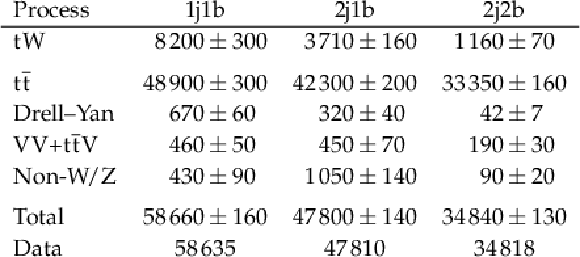
png pdf |
Table 3:
The number of observed and MC predicted events after the fit in the 1j1b, 2j1b, and 2j2b regions. The statistical uncertainties in the data and the total uncertainties in the predictions are given. |

png pdf |
Table 4:
The $ p $-values from the goodness-of-fit tests comparing the six differential cross section measurements with the predictions from POWHEG (PH) + PYTHIA8 (P8) DR and DS and POWHEG + HERWIG 7 (H7) DR. The complete covariance matrix from the results and the statistical uncertainties in the predictions are taken into account. |

png pdf |
Table 5:
The $ p $-values from the goodness-of-fit tests comparing the six differential cross section measurements with the predictions from MadGraph-5_aMC@NLO (aMC) + PYTHIA8 DR, DR2, DS, and DS with a dynamic factor. The complete covariance matrix from the results and the statistical uncertainties in the predictions are taken into account. |
| Summary |
| Inclusive and normalised differential cross sections for the production of a top quark in association with a W boson are measured in proton-proton collision data at $ \sqrt{s}=$ 13.6 TeV. The selected data, corresponding to an integrated luminosity of 34.7 fb$^{-1}$, recorded by the CMS detector, contain events with an electron and a muon of opposite charge. For the inclusive measurement, the events have been categorised depending on the number of jets and jets originating from the fragmentation of bottom quarks. The signal is measured using a maximum likelihood fit to the distribution of random forest discriminants in two of the categories, and to the transverse momentum ($ p_{\mathrm{T}} $) distribution of the second-highest-$ p_{\mathrm{T}} $ jet in a third category. The measured inclusive cross section is 84.1 $ \pm $ 2.1 (stat) $^{+9.8}_{-10.2} $ (syst) $ \pm $ 3.3 (lumi) pb, with a total relative uncertainty of about 13%. This measurement is in agreement with the latest predictions and measurements. The differential cross section measurements are performed as a function of six kinematical observables of the events in the fiducial phase space corresponding to the selection criteria. The results have relative uncertainties in the range of 30-40%, depending on the measured observable. The uncertainties are overall statistically dominated. There is good agreement between the measurements and the predictions from the different event generators. The different approaches used to simulate $ \mathrm{t}\mathrm{W} $ events give similar values in all distributions, which points to small effects of $ \mathrm{t}\mathrm{W} $/ $ \mathrm{t} \overline{\mathrm{t}} $ interference on these distributions in the defined fiducial region. |
| References | ||||
| 1 | S. Frixione et al. | Single-top hadroproduction in association with a W boson | JHEP 07 (2008) 029 | 0805.3067 |
| 2 | A. S. Belyaev, E. E. Boos, and L. V. Dudko | Single top quark at future hadron colliders: Complete signal and background study | PRD 59 (1999) 075001 | hep-ph/9806332 |
| 3 | C. D. White, S. Frixione, E. Laenen, and F. Maltoni | Isolating $ {\mathrm{W}\mathrm{t}} $ production at the LHC | JHEP 11 (2009) 074 | 0908.0631 |
| 4 | CMS Collaboration | Observation of the associated production of a single top quark and a W boson in pp collisions at $ \sqrt{s}= $ 8 TeV | PRL 112 (2014) 231802 | CMS-TOP-12-040 1401.2942 |
| 5 | W. Fang, B. Clerbaux, A. Giammanco, and R. Goldouzian | Model-independent constraints on the CKM matrix elements $ |V_{tb}| $, $ |V_{ts}| $ and $ |V_{td}| $ | JHEP 03 (2019) 022 | 1807.07319 |
| 6 | R. Rahaman and A. Subba | Probing top quark anomalous moments in W boson associated single top quark production at the LHC using polarization and spin correlation | PRD 108 (2023) 055027 | 2306.06889 |
| 7 | T. M. P. Tait and C.-P. Yuan | Single top quark production as a window to physics beyond the standard model | PRD 63 (2000) 014018 | hep-ph/0007298 |
| 8 | Q.-H. Cao, J. Wudka, and C.-P. Yuan | Search for new physics via single top production at the LHC | PLB 658 (2007) 50 | 0704.2809 |
| 9 | V. Barger, M. McCaskey, and G. Shaughnessy | Single top and Higgs associated production at the LHC | PRD 81 (2010) 034020 | 0911.1556 |
| 10 | ATLAS Collaboration | Search for dark matter produced in association with bottom or top quarks in $ \sqrt{s}= $ 13 TeV pp collisions with the ATLAS detector | EPJC 78 (2018) 18 | 1710.11412 |
| 11 | CMS Collaboration | Search for dark matter produced in association with a single top quark or a top quark pair in proton-proton collisions at $ \sqrt{s}= $ 13 TeV | JHEP 03 (2019) 141 | CMS-EXO-18-010 1901.01553 |
| 12 | D. Pinna, A. Zucchetta, M. R. Buckley, and F. Canelli | Single top quarks and dark matter | PRD 96 (2017) 035031 | 1701.05195 |
| 13 | CMS Collaboration | First measurement of the top quark pair production cross section in proton-proton collisions at $ \sqrt{s} = $ 13.6 TeV | JHEP 08 (2023) 204 | CMS-TOP-22-012 2303.10680 |
| 14 | ATLAS Collaboration | Inclusive and differential cross-sections for dilepton $ t\overline{t} $ production measured in $ \sqrt{s} = $ 13 TeV pp collisions with the ATLAS detector | JHEP 07 (2023) 141 | 2303.15340 |
| 15 | N. Kidonakis and N. Yamanaka | Higher-order corrections for $ tW $ production at high-energy hadron colliders | JHEP 05 (2021) 278 | 2102.11300 |
| 16 | N. Kidonakis | Soft-gluon corrections for $ tW $ production at N$ ^3 $LO | PRD 96 (2017) 034014 | 1612.06426 |
| 17 | N. Kidonakis | Two-loop soft anomalous dimensions for single top quark associated production with a $ W^- $ or $ H^- $ | PRD 82 (2010) 054018 | 1005.4451 |
| 18 | PDF4LHC Working Group Collaboration | The PDF4LHC21 combination of global PDF fits for the LHC Run III | JPG 49 (2022) 080501 | 2203.05506 |
| 19 | D0 Collaboration | Observation of single top quark production | PRL 103 (2009) 092001 | 0903.0850 |
| 20 | CDF Collaboration | First observation of electroweak single top quark production | PRL 103 (2009) 092002 | 0903.0885 |
| 21 | ATLAS Collaboration | Evidence for the associated production of a W boson and a top quark in ATLAS at $ \sqrt{s}= $ 7 TeV | PLB 716 (2012) 142 | 1205.5764 |
| 22 | CMS Collaboration | Evidence for associated production of a single top quark and W boson in pp collisions at $ \sqrt{s}= $ 7 TeV | PRL 110 (2013) 022003 | CMS-TOP-11-022 1209.3489 |
| 23 | ATLAS Collaboration | Measurement of the production cross-section of a single top quark in association with a W boson at 8 TeV with the ATLAS experiment | JHEP 01 (2016) 064 | 1510.03752 |
| 24 | CMS Collaboration | Measurement of the production cross section for single top quarks in association with W bosons in proton-proton collisions at $ \sqrt{s}= $ 13 TeV | JHEP 10 (2018) 117 | CMS-TOP-17-018 1805.07399 |
| 25 | ATLAS Collaboration | Measurement of the cross-section for producing a W boson in association with a single top quark in pp collisions at $ \sqrt{s}= $ 13 TeV with ATLAS | JHEP 01 (2018) 063 | 1612.07231 |
| 26 | ATLAS Collaboration | Measurement of differential cross-sections of a single top quark produced in association with a W boson at $ \sqrt{s}= $ 13 TeV with ATLAS | EPJC 78 (2018) 186 | 1712.01602 |
| 27 | ATLAS Collaboration | Probing the quantum interference between singly and doubly resonant top-quark production in pp collisions at $ \sqrt{s}= $ 13 TeV with the ATLAS detector | PRL 121 (2018) 152002 | 1806.04667 |
| 28 | CMS Collaboration | Measurement of inclusive and differential cross sections for single top quark production in association with a W boson in proton-proton collisions at $ \sqrt{s} = $ 13 TeV | JHEP 07 (2023) 046 | CMS-TOP-21-010 2208.00924 |
| 29 | CMS Collaboration | Observation of tW production in the single-lepton channel in pp collisions at $ \sqrt{s} = $ 13 TeV | JHEP 11 (2021) 111 | CMS-TOP-20-002 2109.01706 |
| 30 | ATLAS Collaboration | Measurement of single top-quark production in association with a $ W $ boson in the single-lepton channel at $ \sqrt{s} = $ 8 TeV with the ATLAS detector | EPJC 81 (2021) 720 | 2007.01554 |
| 31 | CMS Collaboration | The CMS experiment at the CERN LHC | JINST 3 (2008) S08004 | |
| 32 | CMS Collaboration | Development of the CMS detector for the CERN LHC Run 3 | Accepted by JINST | CMS-PRF-21-001 2309.05466 |
| 33 | CMS Collaboration | Performance of the CMS Level-1 trigger in proton-proton collisions at $ \sqrt{s}= $ 13 TeV | JINST 15 (2020) P10017 | CMS-TRG-17-001 2006.10165 |
| 34 | CMS Collaboration | The CMS trigger system | JINST 12 (2017) P01020 | CMS-TRG-12-001 1609.02366 |
| 35 | CMS Collaboration | CMS technical design report for the Phase 1 upgrade of the hadron calorimeter | CMS Technical Proposal CERN-LHCC-2012-015, CMS-TDR-010, 2012 CDS |
|
| 36 | CMS Collaboration | Performance of the CMS phase-1 pixel detector with Run 3 data | CMS Detector Performance Note CMS-DP-2022-047, 2022 CDS |
|
| 37 | CMS Collaboration | Commissioning CMS online reconstruction with GPUs | CMS Detector Performance Note CMS-DP-2023-004, 2023 CDS |
|
| 38 | CMS BRIL Collaboration | The Pixel Luminosity Telescope: a detector for luminosity measurement at CMS using silicon pixel sensors | EPJC 83 (2023) 673 | 2206.08870 |
| 39 | N. Karunarathna, for the CMS Collaboration | Run 3 luminosity measurements with the Pixel Luminosity Telescope | in Proc. 41st Int. Conf. on High Energy Phys. (ICHEP ): Bologna, Italy, 2022 [PoS (ICHEP) 936] |
|
| 40 | J. Wańczyk, for the CMS Collaboration | Upgraded CMS Fast Beam Condition Monitor for LHC Run 3 online luminosity and beam-induced background measurements | in Proc. 11th Int. Beam Instrumentation Conf. (IBIC ): Krakow, Poland, 2022 [JACoW (IBIC) 540] |
|
| 41 | CMS Collaboration | Particle-flow reconstruction and global event description with the CMS detector | JINST 12 (2017) P10003 | CMS-PRF-14-001 1706.04965 |
| 42 | CMS Collaboration | Technical proposal for the Phase-II upgrade of the Compact Muon Solenoid | CMS Technical Proposal CERN-LHCC-2015-010, CMS-TDR-15-02, 2015 CDS |
|
| 43 | M. Cacciari, G. P. Salam, and G. Soyez | The anti-$ k_{\mathrm{T}} $ jet clustering algorithm | JHEP 04 (2008) 063 | 0802.1189 |
| 44 | M. Cacciari, G. P. Salam, and G. Soyez | FASTJET user manual | EPJC 72 (2012) 1896 | 1111.6097 |
| 45 | CMS Collaboration | Pileup mitigation at CMS in 13 TeV data | JINST 15 (2020) P09018 | CMS-JME-18-001 2003.00503 |
| 46 | D. Bertolini, P. Harris, M. Low, and N. Tran | Pileup per particle identification | JHEP 10 (2014) 059 | 1407.6013 |
| 47 | CMS Collaboration | Jet energy scale and resolution in the CMS experiment in pp collisions at 8 TeV | JINST 12 (2017) P02014 | CMS-JME-13-004 1607.03663 |
| 48 | CMS Collaboration | Jet energy scale and resolution measurements using prompt Run 3 data collected by CMS in the first months of 2022 at 13.6 TeV | CMS Detector Performance Note CMS-DP-2022-054, 2022 CDS |
|
| 49 | CMS Collaboration | Jet algorithms performance in 13 TeV data | CMS Physics Analysis Summary, 2017 CMS-PAS-JME-16-003 |
CMS-PAS-JME-16-003 |
| 50 | S. Alioli, P. Nason, C. Oleari, and E. Re | A general framework for implementing NLO calculations in shower Monte Carlo programs: the POWHEG \textscbox | JHEP 06 (2010) 043 | 1002.2581 |
| 51 | S. Frixione, P. Nason, and C. Oleari | Matching NLO QCD computations with parton shower simulations: the POWHEG method | JHEP 11 (2007) 070 | 0709.2092 |
| 52 | P. Nason | A new method for combining NLO QCD with shower Monte Carlo algorithms | JHEP 11 (2004) 040 | hep-ph/0409146 |
| 53 | T. M. P. Tait | The $ {\mathrm{t}\mathrm{W^-}} $ mode of single top production | PRD 61 (1999) 034001 | hep-ph/9909352 |
| 54 | J. Alwall et al. | The automated computation of tree-level and next-to-leading order differential cross sections, and their matching to parton shower simulations | JHEP 07 (2014) 079 | 1405.0301 |
| 55 | F. Demartin et al. | $ {\mathrm{t}\mathrm{W}\mathrm{H}} $ associated production at the LHC | EPJC 77 (2017) 34 | 1607.05862 |
| 56 | NNPDF Collaboration | Parton distributions from high-precision collider data | EPJC 77 (2017) 663 | 1706.00428 |
| 57 | T. Sjöstrand et al. | An introduction to PYTHIA 8.2 | Comput. Phys. Commun. 191 (2015) 159 | 1410.3012 |
| 58 | CMS Collaboration | Extraction and validation of a new set of CMS PYTHIA 8 tunes from underlying-event measurements | EPJC 80 (2020) 4 | CMS-GEN-17-001 1903.12179 |
| 59 | M. Bahr et al. | HERWIG++ physics and manual | EPJC 58 (2008) 639 | 0803.0883 |
| 60 | J. Bellm et al. | HERWIG 7.0/ HERWIG++ 3.0 release note | EPJC 76 (2016) 196 | 1512.01178 |
| 61 | J. Bellm et al. | HERWIG 7.1 release note | 1705.06919 | |
| 62 | CMS Collaboration | Development and validation of HERWIG 7 tunes from CMS underlying-event measurements | EPJC 81 (2021) 312 | CMS-GEN-19-001 2011.03422 |
| 63 | R. Frederix and S. Frixione | Merging meets matching in MC@NLO | JHEP 12 (2012) 061 | 1209.6215 |
| 64 | GEANT4 Collaboration | GEANT 4---a simulation toolkit | NIM A 506 (2003) 250 | |
| 65 | Y. Li and F. Petriello | Combining QCD and electroweak corrections to dilepton production in the framework of the FEWZ simulation code | PRD 86 (2012) 094034 | 1208.5967 |
| 66 | J. M. Campbell, R. K. Ellis, and C. Williams | Vector boson pair production at the LHC | JHEP 07 (2011) 018 | 1105.0020 |
| 67 | M. Czakon, P. Fiedler, and A. Mitov | Total top-quark pair-production cross section at hadron colliders through $ {O(\alpha_\mathrm{S}^4)} $ | PRL 110 (2013) 252004 | 1303.6254 |
| 68 | M. Czakon and A. Mitov | \textsctop++: A program for the calculation of the top-pair cross-section at hadron colliders | Comput. Phys. Commun. 185 (2014) 2930 | 1112.5675 |
| 69 | CMS Collaboration | Measurement of the inelastic proton-proton cross section at $ \sqrt{s}= $ 13 TeV | JHEP 07 (2018) 161 | CMS-FSQ-15-005 1802.02613 |
| 70 | CMS Collaboration | Electron and photon reconstruction and identification with the CMS experiment at the CERN LHC | JINST 16 (2021) P05014 | CMS-EGM-17-001 2012.06888 |
| 71 | CMS Collaboration | Performance of the CMS muon detector and muon reconstruction with proton-proton collisions at $ \sqrt{s}= $ 13 TeV | JINST 13 (2018) P06015 | CMS-MUO-16-001 1804.04528 |
| 72 | H. Qu, C. Li, and S. Qian | Particle Transformer for Jet Tagging | 2202.03772 | |
| 73 | CMS Collaboration | Adversarial training for b-tagging algorithms in CMS | CMS Detector Performance Note CMS-DP-2022-049, 2022 CDS |
|
| 74 | CMS Collaboration | Transformer models for heavy flavor jet identification | CMS Detector Performance Note CMS-DP-2022-050, 2022 CDS |
|
| 75 | CMS Collaboration | Identification of heavy-flavour jets with the CMS detector in pp collisions at 13 TeV | JINST 13 (2018) P05011 | CMS-BTV-16-002 1712.07158 |
| 76 | E. Bols et al. | Jet flavour classification using DeepJet | JINST 15 (2020) P12012 | 2008.10519 |
| 77 | A. Prinzie and D. Van den Poel | Random multiclass classification: Generalizing random forests to random MNL and random NB | in Proc. 18th International Conference on Database and Expert Systems Applications (DEXA ): Regensburg, Germany, 2007 link |
|
| 78 | L. Breiman, J. Friedman, C. J. Stone, and R. A. Olshen | Classification and regression trees | Chapman and Hall, ISBN 0-412-048141-8, 1984 | |
| 79 | F. Pedregosa et al. | Scikit-learn: Machine learning in Python | Journal of Machine Learning Research 12 (2011) 2825 | |
| 80 | R. Cousins | Generalization of chisquare goodness-of-fit test for binned data using saturated models, with application to histograms | link | |
| 81 | R. J. Barlow and C. Beeston | Fitting using finite Monte Carlo samples | Comput. Phys. Commun. 77 (1993) 219 | |
| 82 | J. S. Conway | Incorporating nuisance parameters in likelihoods for multisource spectra | in Proc. 2011 Workshop on Statistical Issues Related to Discovery Claims in Search Experiments and Unfolding (PHYSTAT ): Geneva, 2011 link |
1103.0354 |
| 83 | L. Moneta et al. | The RooStats project | in Proc. 13th Int. Workshop on Advanced Computing and Analysis Techniques in Phys. Research (ACAT ): Jaipur, India, 2010 [PoS (ACAT) 057] |
1009.1003 |
| 84 | S. Schmitt | TUnfold: an algorithm for correcting migration effects in high energy physics | JINST 7 (2012) T10003 | 1205.6201 |
| 85 | CMS Collaboration | Object definitions for top quark analyses at the particle level | Technical Report CMS-NOTE-2017-004, 2017 CDS |
|
| 86 | M. Cacciari, G. P. Salam, and G. Soyez | The Catchment Area of Jets | JHEP 04 (2008) 005 | 0802.1188 |
| 87 | CMS Collaboration | Performance of photon reconstruction and identification with the CMS detector in proton-proton collisions at $ \sqrt{s}= $ 8 TeV | JINST 10 (2015) P08010 | CMS-EGM-14-001 1502.02702 |
| 88 | CMS Collaboration | Description and performance of track and primary-vertex reconstruction with the CMS tracker | JINST 9 (2014) P10009 | CMS-TRK-11-001 1405.6569 |
| 89 | CMS Collaboration | Measurements of inclusive W and Z cross sections in pp collisions at $ \sqrt{s}= $ 7 TeV | JHEP 01 (2011) 080 | CMS-EWK-10-002 1012.2466 |
| 90 | ATLAS Collaboration | Measurement of the inelastic proton-proton cross section at $ \sqrt{s}= $ 13 TeV with the ATLAS detector at the LHC | PRL 117 (2016) 182002 | 1606.02625 |
| 91 | CMS Collaboration | Luminosity measurement in proton-proton collisions at 13.6 TeV in 2022 at CMS | CMS Physics Analysis Summary, 2024 CMS-PAS-LUM-22-001 |
CMS-PAS-LUM-22-001 |
| 92 | P. Skands, S. Carrazza, and J. Rojo | Tuning PYTHIA 8.1: the Monash 2013 tune | EPJC 74 (2014) 3024 | 1404.5630 |
| 93 | ATLAS and CMS Collaborations | Improved Common $ t\bar{t} $ Monte-Carlo Settings for ATLAS and CMS | Technical Report CMS-NOTE-2023-004, CERN-CMS-NOTE-2023-004, ATL-PHYS-PUB-2023-016, 2023 | |
| 94 | S. Argyropoulos and T. Sjöstrand | Effects of color reconnection on $ \mathrm{t} \overline{\mathrm{t}} $ final states at the LHC | JHEP 11 (2014) 043 | 1407.6653 |
| 95 | CMS Collaboration | CMS pythia 8 colour reconnection tunes based on underlying-event data | EPJC 83 (2023) 587 | CMS-GEN-17-002 2205.02905 |
| 96 | CMS Collaboration | Investigations of the impact of the parton shower tuning in PYTHIA 8 in the modelling of $ \mathrm{t} \overline{\mathrm{t}} $ at $ \sqrt{s}= $ 8 and 13 TeV | CMS Physics Analysis Summary, 2016 CMS-PAS-TOP-16-021 |
CMS-PAS-TOP-16-021 |
| 97 | CMS Collaboration | Measurement of the top quark mass using proton-proton data at $ \sqrt{s}= $ 7 and 8 TeV | PRD 93 (2016) 072004 | CMS-TOP-14-022 1509.04044 |
| 98 | CMS Collaboration | Measurement of differential cross sections for top quark pair production using the lepton+jets final state in proton-proton collisions at 13 TeV | PRD 95 (2017) 092001 | CMS-TOP-16-008 1610.04191 |
| 99 | CMS Collaboration | Measurement of the differential cross section for top quark pair production in pp collisions at $ \sqrt{s}= $ 8 TeV | EPJC 75 (2015) 542 | CMS-TOP-12-028 1505.04480 |
| 100 | CMS Collaboration | Measurement of the $ \mathrm{t} \overline{\mathrm{t}} $ production cross section in the all-jets final state in pp collisions at $ \sqrt{s}= $ 8 TeV | EPJC 76 (2016) 128 | CMS-TOP-14-018 1509.06076 |

|
Compact Muon Solenoid LHC, CERN |

|

|

|

|

|

|